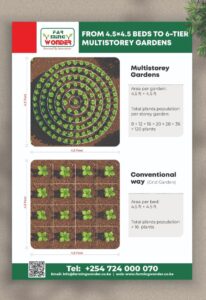Executive summary
Kenya faces persistent and, in some places, worsening food insecurity and childhood malnutrition. Local, space-efficient production of nutrient-dense vegetables can directly raise household dietary diversity and reduce micronutrient deficiency risk. Our multistorey gardens increase plant density from 16 seedlings to 120 seedlings on the same 2 m² footprint — a 7.5× improvement in planting capacity. This scale-up of home production translates into more frequent access to fresh greens, greater dietary diversity, and improved resilience against shocks driven by climate, price inflation and supply disruptions. Evidence from household-level garden interventions and recent research on vertical/urban gardening shows measurable benefits for food security and nutrition when adoption and water/seed inputs are sufficient.
The problem (short, data-backed)
Global and regional hunger is rising: the 2025 Global Report on Food Crises reports that hundreds of millions of people experienced crisis or worse levels of food insecurity recently, driven by conflict, climate shocks and economic stressors — conditions that also affect Kenya.
Child malnutrition remains a public health concern: recent inter-agency estimates (UNICEF/WHO/World Bank) show persistent stunting and wasting in young children globally, with country-specific hotspots in Kenya where stunting and wasting vary widely across counties. UNICEF Kenya highlights county variations—stunting as high as ~46% in some counties, and wasting exceeding 20% in arid areas—showing that access to micronutrient-rich foods is highly uneven.
Why space matters (simple calculation + interpretation)
Baseline: 16 seedlings in 2 m² → 8 seedlings/m².
With multistorey gardens: 120 seedlings in 2 m² → 60 seedlings/m².
Relative gain: 120 ÷ 16 = 7.5 → 7.5× more seedlings on the same ground footprint.
Practical interpretation: 7.5× more planting points means a household can (a) grow a wider variety of vegetables concurrently (leafy greens, brassicas, herbs, vine crops), (b) harvest continuously (staggered planting/cut-and-come-again), and (c) allocate production for both consumption and modest sale/trade — all using the same limited space. This is especially critical in urban or peri-urban homes, schools, institutions, and small plots where ground area is the binding constraint.
Nutrition and food security implications (with evidence)
1. More vegetables = more micronutrients and dietary diversity. Vegetables are high-value sources of vitamins A, C, folate, iron (bioavailability varies), and fibre. Greater availability and consumption of a variety of vegetables reduce the risk of micronutrient deficiencies.
2. Home gardens improve household food access and diet quality. Multiple studies from East Africa and Kenya link home gardening (including sack/vertical gardening) to improved availability of vegetables, dietary diversity and sometimes better child nutrition indicators when programs include training, seed access, and water management. Vertical gardening in recent research is associated with greater household resilience and nutritional security in urban settings.
3. Shock resilience: producing food at home buffers households from market price spikes and supply chain interruptions—factors that have driven increases in acute food insecurity globally and regionally. Local production is a cost-effective, dignity-preserving strategy recommended in recent food-crisis analyses.
What the 7.5× gain can mean in real terms (illustrative pathway)
Availability: More frequent harvests of greens (e.g., sukuma wiki/collards, spinach, amaranth) — households move from weekly to near-daily fresh vegetable access.
Utilisation: Fresh vegetables support complementary feeding (6–23 months) and maternal nutrition — the window where better nutrient intake has outsized impact on child growth and development.
Income & access: Surplus produce can be sold informally, improving household purchasing power for staples and other foods. Even small revenues stabilize food access during lean months.
Recommendations (actionable, for donors, governments, NGOs, corporates)
1. Scale space-efficient gardening (multistorey/vertical) in urban and peri-urban programming where land is scarce. Prioritise sites with high malnutrition or food insecurity prevalence.
2. Bundle gardens with nutrition education (targeting complementary feeding and women caregivers) so increased production converts to improved diets.
3. Ensure seed, water, and training support for at least the first 6–12 months; monitor dietary diversity and child growth where feasible. Studies show home garden projects deliver the greatest nutrition returns when these supports exist.
4. Integrate with schools & institutions to reach children directly (school gardens) and use procurement channels for community kitchens and local markets. Vertical multistorey systems are ideal for school compounds with small footprints.
Short closing
Space is not destiny — it’s an opportunity. When we convert 2 m² from a low-yield patch into a 120-seedling multistorey plot, we multiply the household’s ability to feed, nourish, and earn. Scaling these gardens across urban and vulnerable rural communities is a practical, evidence-informed step toward reducing micronutrient gaps and strengthening local food systems. If you work in nutrition, urban planning, education, or community development and want to pilot multistorey gardens or evaluate impact, let’s connect — Farming Wonder has field experience and models ready to adapt locally.

